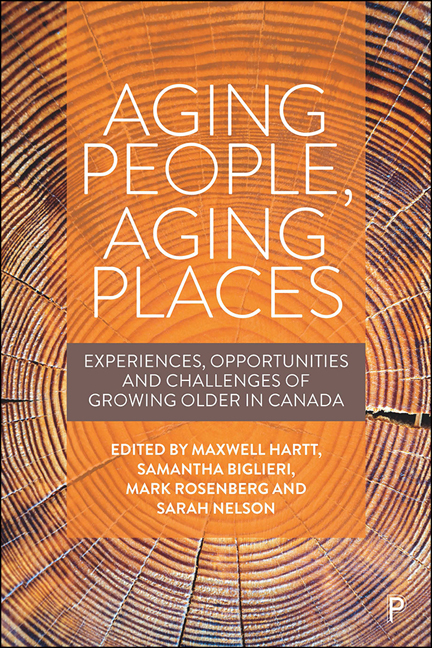6 - Aging in suburban Canada
Published online by Cambridge University Press: 18 December 2021
Summary
In this overview chapter, we call upon data from Statistics Canada and the academic literature to present some stylized facts and figures regarding suburban older adults and a synthesis of the challenges and opportunities of aging in suburban environments. This chapter serves to provide (1) a snapshot of Canadian suburban demographic trends, (2) an overview of the state-of-the-art thinking on suburban aging, and (3) contextual framing for the in-depth research chapters and vignettes that make up the suburban part of this book.
Canada's built environment and population growth predominantly occurs on the (sometimes sprawling) urban fringe. Put simply, Canada is a suburban nation. In Canada's largest metropolitan areas, including Vancouver, Montréal, and Toronto, the proportion of suburban residents exceeds 80% (Gordon and Janzen, 2013).
Generally, traditional forms of suburban locations can be characterized by a variety of factors including the proportion of single-family housing, car commuting patterns, population density, and home-ownership rates. However, we recognize that the modern suburban landscape is complex and diverse (Keil, 2017) and that there is no single perfect operational definition of suburban (Forsyth, 2012). We adopt the following operational definition in order to provide a generalized overview of suburban demographic trends in Canada: suburban areas are dissemination areas (as defined by Statistics Canada) with a population density between 1,000 and 4,000 people per square kilometre with over 60% of commutes made by car, or simply with a population density of 400–1,000 people per square kilometre (Channer et al, 2020).
Using the data from the Statistics Canada (2019a) population estimates, we found that more than half (18 million) of Canada's population resides in suburban areas. Of those 18 million, just over 3 million are aged 65 and over. Proportionally, 17% of suburban Canadians are aged 65 and over, compared to urban (15%) and rural (18%). The proportion of older adults across Canada is expected to rise rapidly in upcoming years as more of the baby boom generation turns 65. In 2018, 17% of the country's population were aged 65 or over, compared with 14% in 2011. According to Statistics Canada's (2019b) demographic projections, by 2024 one in five Canadians is expected to be aged 65 and older. Canada's demographic shift is not only about baby boomers reaching retirement age. Nationwide, the cohort of Canadians aged 85 and over is also growing very quickly.
- Type
- Chapter
- Information
- Aging People, Aging PlacesExperiences, Opportunities and Challenges of Growing Older in Canada, pp. 81 - 88Publisher: Bristol University PressPrint publication year: 2021

